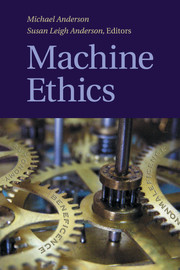Book contents
- Frontmatter
- Contents
- General Introduction
- PART I THE NATURE OF MACHINE ETHICS
- PART II THE IMPORTANCE OF MACHINE ETHICS
- PART III ISSUES CONCERNING MACHINE ETHICS
- PART IV APPROACHES TO MACHINE ETHICS
- Introduction
- 14 Towards the Ethical Robot
- 15 Asimov's Laws of Robotics
- 16 The Unacceptability of Asimov's Three Laws of Robotics as a Basis for Machine Ethics
- 17 Computational Models of Ethical Reasoning
- 18 Computational Neural Modeling and the Philosophy of Ethics
- 19 Architectures and Ethics for Robots
- 20 Piagetian Roboethics via Category Theory
- 21 Ethical Protocols Design
- 22 Modeling Morality with Prospective Logic
- 23 An Integrated Reasoning Approach to Moral Decision Making
- 24 Prototyping N-Reasons
- 25 There Is No “I” in “Robot”
- 26 Prospects for a Kantian Machine
- 27 A Prima Facie Duty Approach to Machine Ethics
- PART V VISIONS FOR MACHINE ETHICS
- References
21 - Ethical Protocols Design
from PART IV - APPROACHES TO MACHINE ETHICS
Published online by Cambridge University Press: 01 June 2011
- Frontmatter
- Contents
- General Introduction
- PART I THE NATURE OF MACHINE ETHICS
- PART II THE IMPORTANCE OF MACHINE ETHICS
- PART III ISSUES CONCERNING MACHINE ETHICS
- PART IV APPROACHES TO MACHINE ETHICS
- Introduction
- 14 Towards the Ethical Robot
- 15 Asimov's Laws of Robotics
- 16 The Unacceptability of Asimov's Three Laws of Robotics as a Basis for Machine Ethics
- 17 Computational Models of Ethical Reasoning
- 18 Computational Neural Modeling and the Philosophy of Ethics
- 19 Architectures and Ethics for Robots
- 20 Piagetian Roboethics via Category Theory
- 21 Ethical Protocols Design
- 22 Modeling Morality with Prospective Logic
- 23 An Integrated Reasoning Approach to Moral Decision Making
- 24 Prototyping N-Reasons
- 25 There Is No “I” in “Robot”
- 26 Prospects for a Kantian Machine
- 27 A Prima Facie Duty Approach to Machine Ethics
- PART V VISIONS FOR MACHINE ETHICS
- References
Summary
Introduction
The responsibilities of a system designer are growing and expanding in fields that only ten years ago were the exclusive realms of philosophy, sociology, or jurisprudence. Nowadays, a system designer must have a deep understanding not only of the social and legal implications of what he is designing, but also of the ethical nature of the systems he is conceptualizing. These artifacts not only behave autonomously in their environments, embedding themselves into the functional tissue or our society but also “re-ontologise” part of our social environment, shaping new spaces in which people operate.
It is in the public interest that automated systems minimize their usage of limited resources, are safe for users, and integrate ergonomically within the dynamics of everyday life. For instance, one expects banks to offer safe, multifunction ATMs, hospitals to ensure that electro-medical instruments do not electrocute patients, and nuclear plants to employ redundant, formally specified control systems.
It is equally important to the public interest that artificial autonomous entities behave correctly. Autonomous and interactive systems affect the social life of millions of individuals, while performing critical operations such as managing sensitive information, financial transactions, or the packaging and delivery of medicines. The development of a precise understanding of what it means for such artifacts to behave in accordance with the ethical principles endorsed by a society is a pressing issue.
- Type
- Chapter
- Information
- Machine Ethics , pp. 375 - 397Publisher: Cambridge University PressPrint publication year: 2011
References
- 2
- Cited by



